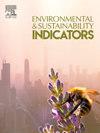东盟地区污染避风港和倒n型EKC假设检验:FDI和能源结构对环境质量的影响
IF 5.4
Q1 ENVIRONMENTAL SCIENCES
引用次数: 0
摘要
本文研究了1995 - 2020年9个东南亚国家的外商直接投资(FDI)、GDP、可再生能源、不可再生能源、核能之间的关系,以及它们对生态足迹(EFP)的综合影响。采用分位数回归、固定效应和随机效应模型,以及完全修正普通最小二乘(FMOLS)、动态普通最小二乘(DOLS)和典型协整回归(CCR)方法进行稳健性评估,研究得出了令人信服的见解。与传统的环境库兹涅茨曲线(EKC)理论相反,研究结果揭示了反向EKC和倒n型EKC的存在。具体而言,GDP表现为负系数,而二次项和三次项分别表现为正系数和负系数。值得注意的是,立方GDP成为改善EFP和提高环境质量的关键因素。研究结果表明,FDI与EFP之间存在非线性(n型)关系,在不同的FDI流入阶段会出现污染天堂(PHH)和污染光环效应。此外,不可再生能源和核能与化石燃料一起显示出正系数,表明它们对环境的负面影响。这项研究强调了平衡经济增长、可持续的外国直接投资战略和能源效率的重要性,以支持东盟的长期环境可持续性和更绿色的未来。本文章由计算机程序翻译,如有差异,请以英文原文为准。
Testing the pollution haven and inverted N-shaped EKC hypotheses in the ASEAN Region: The impact of FDI and energy mix on environmental quality
This study investigates the relationships between Foreign Direct Investment (FDI), GDP, renewable energy, non-renewable energy, nuclear energy, and their combined influence on ecological footprint (EFP) in nine Southeast Asian (ASEAN) countries from 1995 to 2020. Employing Quantile Regression, Fixed Effect, and Random Effect models, alongside Fully Modified Ordinary Least Squares (FMOLS), Dynamic Ordinary Least Squares (DOLS), and Canonical Cointegrating Regression (CCR) methods for robustness assessment, the research yields compelling insights. Contrary to the conventional theory of the Environmental Kuznets Curve (EKC), the findings reveal the presence of reversed EKC and inverted N-Shaped EKC. Specifically, GDP exhibits a negative coefficient, while the quadratic and cubic terms display positive and negative coefficients, respectively. Notably, cubic GDP emerge as key factors in ameliorating EFP and enhancing environmental quality. The findings indicate a non-linear (N-shaped) relationship between FDI and EFP, where both the pollution heaven (PHH) and Pollution Halo effect can occur depending on the stage of FDI inflow. Additionally, non-renewable and nuclear energy sources, alongside fossil fuels, exhibit positive coefficients, signifying their negative environmental implications. This study underscores the importance of balancing economic growth, sustainable FDI strategies, and energy efficiency to support long-term environmental sustainability and greener future for ASEAN.
求助全文
通过发布文献求助,成功后即可免费获取论文全文。
去求助
来源期刊

Environmental and Sustainability Indicators
Environmental Science-Environmental Science (miscellaneous)
CiteScore
7.80
自引率
2.30%
发文量
49
审稿时长
57 days
 求助内容:
求助内容: 应助结果提醒方式:
应助结果提醒方式:


